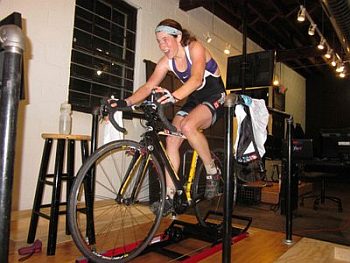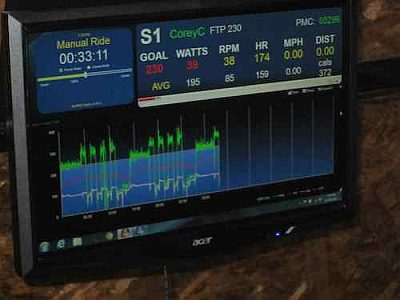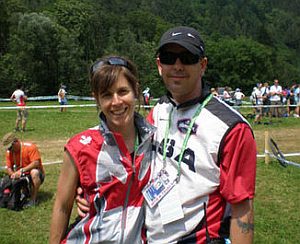Motor-pacing with The Fix
 This fall, I have been working with The Fix Studio to improve my cyclocross performances. The Fix Studio is owned by husband-wife team, Larry Foss and Sophie St. Jacques. They have been a tremendous help to my training and my results are suddenly trending upward! Their studio is located on Minnehaha Ave in South Minneapolis, a convenient 1.3 miles from my home, I might add. Larry and Sophie’s extensive riding, coaching, strength and conditioning, massage, and soigneur experience is detailed on their website (www.thefixstudio.com), but suffice it to say, it’s extensive. The studio has space for classes, testing, massage, and bike maintenance, and Larry, Sophie, staff, and their poodle Mavis make the place a fun, welcoming locale for endurance sports junkies.
This fall, I have been working with The Fix Studio to improve my cyclocross performances. The Fix Studio is owned by husband-wife team, Larry Foss and Sophie St. Jacques. They have been a tremendous help to my training and my results are suddenly trending upward! Their studio is located on Minnehaha Ave in South Minneapolis, a convenient 1.3 miles from my home, I might add. Larry and Sophie’s extensive riding, coaching, strength and conditioning, massage, and soigneur experience is detailed on their website (www.thefixstudio.com), but suffice it to say, it’s extensive. The studio has space for classes, testing, massage, and bike maintenance, and Larry, Sophie, staff, and their poodle Mavis make the place a fun, welcoming locale for endurance sports junkies.
I was first drawn to the studio for their motor-pacing services, but now I also benefit from their PowerFIX classes, coaching, and some massage.
 Both PowerFIX classes and motor-pacing are kept at appropriate intensities using power data. I began my training at The Fix with a lactate test with Larry. While such testing is the gold standard for determining zones, The Fix also uses time trials, as well as their extensive experience to nail down zones. In PowerFIX classes, riders use their own bike in a CompuTrainer set-up. The riders have all the data they need to follow the day’s workout on the screen in front of them, and that data is also visible on a master computer. Given the available data, and fact that the class size is limited to 8, adjustments to intensity levels can be made on the fly. On Tuesday mornings following two days of racing, Sophie has made such adjustments for me when her data, as well as the grimace on my face, told her that I was going south, fast!
Both PowerFIX classes and motor-pacing are kept at appropriate intensities using power data. I began my training at The Fix with a lactate test with Larry. While such testing is the gold standard for determining zones, The Fix also uses time trials, as well as their extensive experience to nail down zones. In PowerFIX classes, riders use their own bike in a CompuTrainer set-up. The riders have all the data they need to follow the day’s workout on the screen in front of them, and that data is also visible on a master computer. Given the available data, and fact that the class size is limited to 8, adjustments to intensity levels can be made on the fly. On Tuesday mornings following two days of racing, Sophie has made such adjustments for me when her data, as well as the grimace on my face, told her that I was going south, fast!
The Fix has a slick power/heart rate set-up for motor-pacing. The rider uses a power-meter and heart-rate monitor (power-tap wheels and Garmin computers are available for rent from The Fix). The monitors are picked up by Garmin computers on the motor and on the rider’s bike. Larry, who conducts all the motor-pacing sessions, uses this data to set the pace and the length of rest intervals. The data also helps him to decide when the workout needs to end (if the rider can no longer sustain the power and/or the heart rate does not come down). All this data is of most value when Larry returns to The Fix and analyzes it. For me, the data is just a bunch of pretty graphs, so it's a relief to be able to count on Larry to provide interpretation.

When I envisioned motor-pacing, I imagined sitting in behind the motor for hours on end at approximately threshold effort. While that type of motor-pacing is available at The Fix (Larry will do "your workouts" or help to define workouts that address your limiters), that's not how Larry coaches cyclocross. In short, my workouts are brief, really difficult, and filled with pace changes (kind of like cross!). We started with short hill repeats behind the motor. Using my power zones and the motor's mirrors, Larry pulled me up the hill at a pace I could hardly sustain, and then as we crested the hill, drove the pace up one more notch. This worked on my ability to edge up the pace when I am already in trouble. More recently, we did intervals in which I followed the motor at a brisk pace, came around at a sprint, and then got back on to recover. In essence, we were working on attacking, and then recovering while still at speed.
One of the great things about this workout is the one-on-one attention and specificity to my needs. While The Fix will motor pace a small group, I highly recommend the one-on-one sessions. On a group ride or doing intervals with friends, the quality of your workout is dependent the other riders. If they go too fast and drop you, your workout is over. The motor-pacing workouts are consistently just a tiny bit tougher than I would have planned for myself. With the data, as well as Larry’s paying attention to my every move and grimace, he can adjust the workout to get as much as he can from me without asking for too much.
Racing isn't just about how far you can go into the pain cave, it's also about being efficient. With my background as an elite Nordic skier, I have the engine, but I still feel like an imposter on a bike. Besides Larry watching me over his shoulder and in the mirrors, he also tapes the sessions with a GoPro mounted on the back of the motor. While I would hate for any of these movies that capture my every facial contortion and snot string to see the light of day, I can see how they offer Larry the capacity to analyze my form relative to the intensity of the effort. The Fix also uses video in the studio during PowerFIX, so there no escaping good technique…ever.
 I was pretty scared for my first motor-pacing workout. This summer, I did a fair amount of group riding, road races, and even trained at the velodrome, so I am pretty comfortable in a draft. But this was following a motor at a close distance! However, Larry did a fabulous job explaining what we would do, and generally just being a confident, calming influence. He is super-duper steady and safe on the motor, and I trust him completely. The motor also has a roll bar, and I am happy to report that I have touched it and did not die! (It rolls around and you slide back uneventfully.)
I was pretty scared for my first motor-pacing workout. This summer, I did a fair amount of group riding, road races, and even trained at the velodrome, so I am pretty comfortable in a draft. But this was following a motor at a close distance! However, Larry did a fabulous job explaining what we would do, and generally just being a confident, calming influence. He is super-duper steady and safe on the motor, and I trust him completely. The motor also has a roll bar, and I am happy to report that I have touched it and did not die! (It rolls around and you slide back uneventfully.)
The Fix Studio philosophy seems to be go out and get 'er done. Central to this is the fact that Larry uses routes that are 15–20 minutes (by bike) from the studio. While you would not think you could motor-pace in the city, there are appropriate short stretches in St. Paul and Mendota Heights with low traffic and safe pavement. While Larry takes the time to explain the workout and answer questions, he comes with a clear plan and sticks to it. The result is an effective and challenging workout in about an hour.
I will continue to motor-pace throughout the fall until road conditions become unsafe to do so. I also attend class at The Fix once a week. While motor-pacing is definitely more of an adrenaline rush, the classes are nearly as effective and not dependent on weather and daylight. As with motor-pacing, classes are short, structured, and intense. Each day of class addresses a specific aspect of cycling conditioning, for example: VO2 Max. Classes start on time and take exactly an hour. Let’s face it, they hurt! However the combination of a group setting, the pressure of continuous recording of power data, instructor attention, and good music combine to get more out of me than I would ever get from myself alone in my basement.
I’m super grateful to The Fix for shaking things up in my training and also making me faster. Stay tuned to see how much faster Larry and Sophie can make me!

